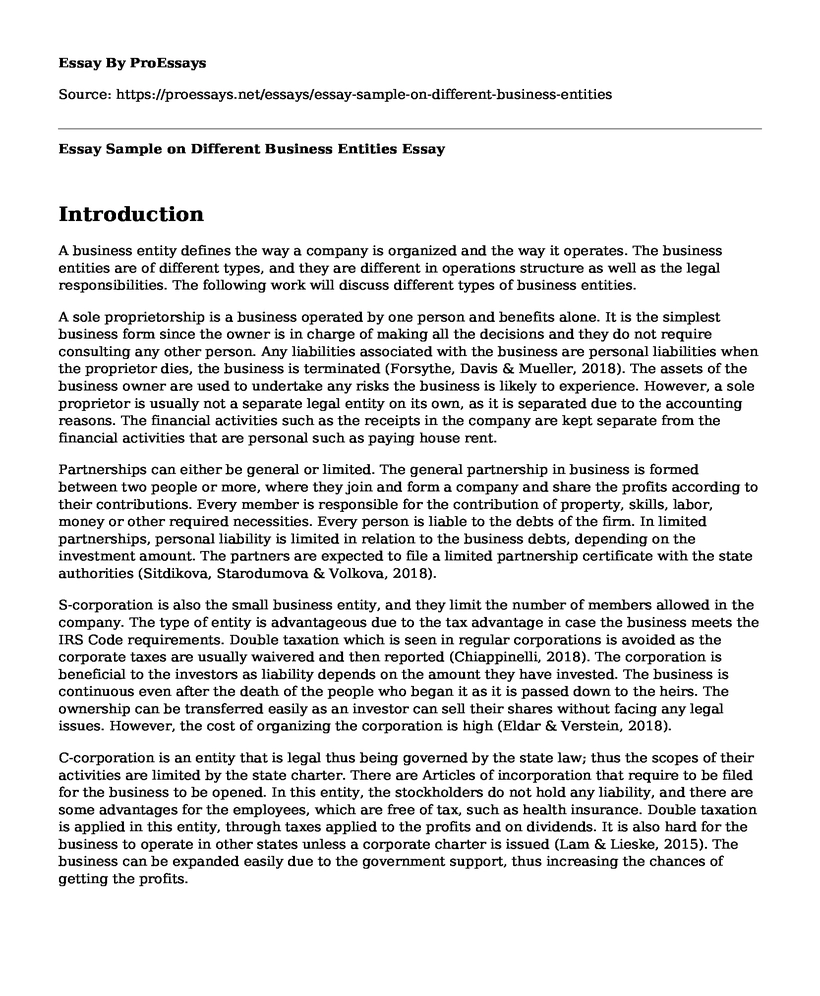Introduction
A business entity defines the way a company is organized and the way it operates. The business entities are of different types, and they are different in operations structure as well as the legal responsibilities. The following work will discuss different types of business entities.
A sole proprietorship is a business operated by one person and benefits alone. It is the simplest business form since the owner is in charge of making all the decisions and they do not require consulting any other person. Any liabilities associated with the business are personal liabilities when the proprietor dies, the business is terminated (Forsythe, Davis & Mueller, 2018). The assets of the business owner are used to undertake any risks the business is likely to experience. However, a sole proprietor is usually not a separate legal entity on its own, as it is separated due to the accounting reasons. The financial activities such as the receipts in the company are kept separate from the financial activities that are personal such as paying house rent.
Partnerships can either be general or limited. The general partnership in business is formed between two people or more, where they join and form a company and share the profits according to their contributions. Every member is responsible for the contribution of property, skills, labor, money or other required necessities. Every person is liable to the debts of the firm. In limited partnerships, personal liability is limited in relation to the business debts, depending on the investment amount. The partners are expected to file a limited partnership certificate with the state authorities (Sitdikova, Starodumova & Volkova, 2018).
S-corporation is also the small business entity, and they limit the number of members allowed in the company. The type of entity is advantageous due to the tax advantage in case the business meets the IRS Code requirements. Double taxation which is seen in regular corporations is avoided as the corporate taxes are usually waivered and then reported (Chiappinelli, 2018). The corporation is beneficial to the investors as liability depends on the amount they have invested. The business is continuous even after the death of the people who began it as it is passed down to the heirs. The ownership can be transferred easily as an investor can sell their shares without facing any legal issues. However, the cost of organizing the corporation is high (Eldar & Verstein, 2018).
C-corporation is an entity that is legal thus being governed by the state law; thus the scopes of their activities are limited by the state charter. There are Articles of incorporation that require to be filed for the business to be opened. In this entity, the stockholders do not hold any liability, and there are some advantages for the employees, which are free of tax, such as health insurance. Double taxation is applied in this entity, through taxes applied to the profits and on dividends. It is also hard for the business to operate in other states unless a corporate charter is issued (Lam & Lieske, 2015). The business can be expanded easily due to the government support, thus increasing the chances of getting the profits.
Conclusion
In conclusion, when opening a business, one has to choose a business entity. It is essential to make sure that they analyze the benefits and demerits. It will help chose the best entity that will see the success of the company.
References
Chiappinelli, E. A. (2018). Cases and materials on business entities. Wolters Kluwer Law & Business. Eldar, O., & Verstein, A. (2018). The Enduring Distinction Between Business Entities and Security Interests.
Forsythe, L. M., Davis, L. Y., & Mueller, J. M. (2018). Guiding Entrepreneurs Through the Quagmire of Business Entities-Three Hypothetical Scenarios for Discussion. Entrepreneurship Education and Pedagogy, 1(3), 258-271.
Lam, M. T., & Lieske, J. H. (2015). U.S. Patent No. 9,177,068. Washington, DC: U.S. Patent and Trademark Office.
Sitdikova, L. B., Starodumova, S. J., & Volkova, M. A. (2018). Aspects of Transactions by Business Entities in Civil Legislation. European Research Studies Journal, 21(4), 557-566.
Cite this page
Essay Sample on Different Business Entities. (2022, Nov 21). Retrieved from https://proessays.net/essays/essay-sample-on-different-business-entities
If you are the original author of this essay and no longer wish to have it published on the ProEssays website, please click below to request its removal:
- Business Ethics Research
- Essay Example on Law and Ethics in Business Environment
- The Central Challenge of Global Strategy Essay
- Corporate Social Responsibility at Olive Garden Essay
- The Traits of Successful Entrepreneurs - Paper Example
- D&B Jamaican Jerk Restaurant - Evaluation Essay
- The Technology Employed by Tres Latin Foods Companies Paper Example







